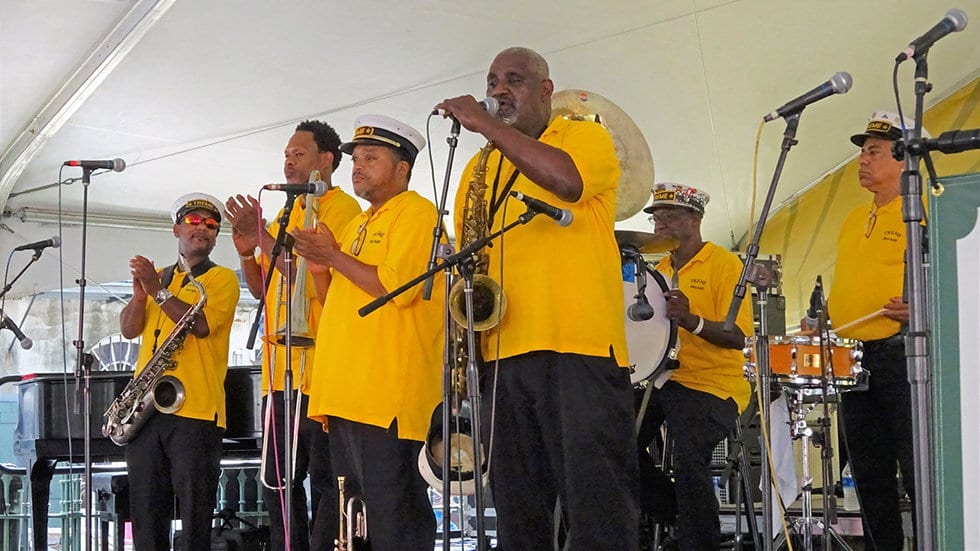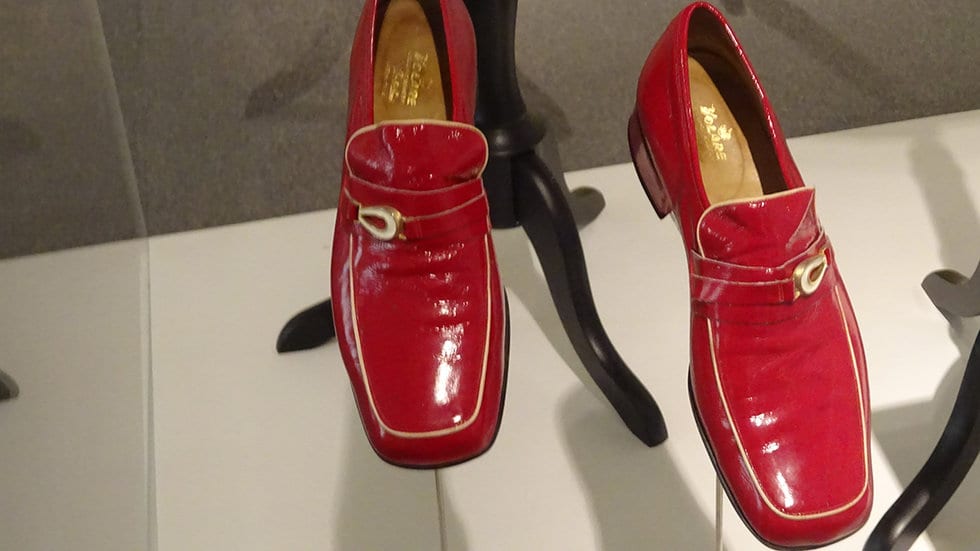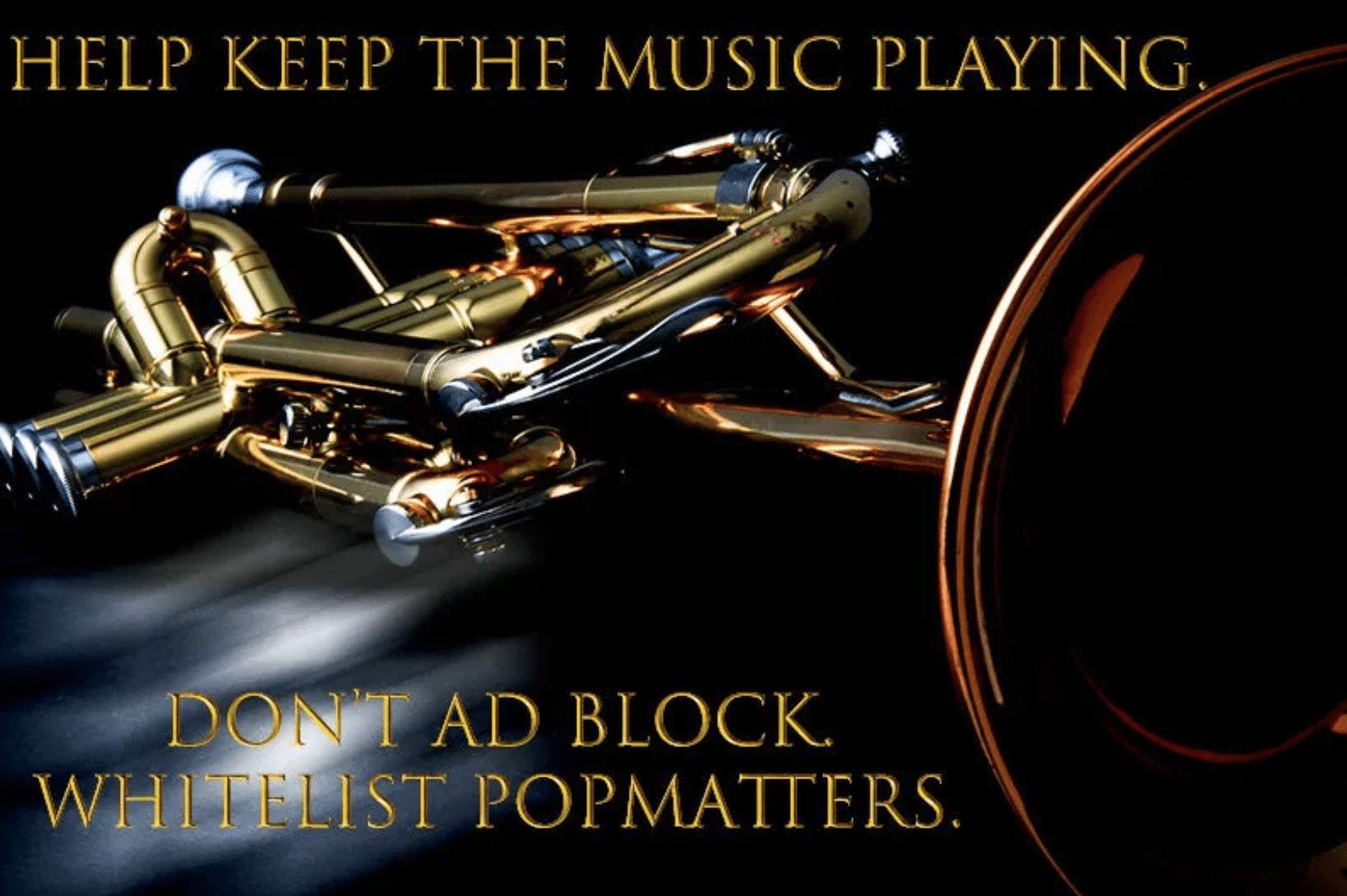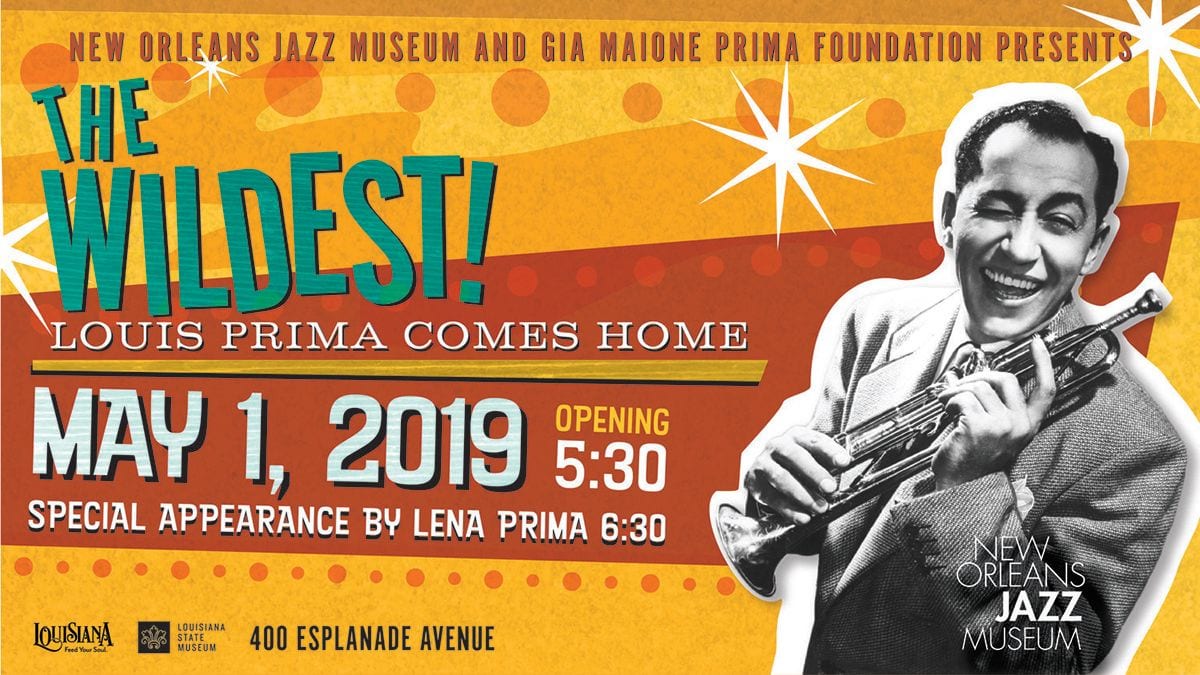“Pops is in the house!” exclaimed Shannon Powell during his evening set at Satchmo Summerfest. Powell, one of New Orleans’ most prominent drummers, played perhaps the most Satchmo-esque set at the three-day festival (August 2-4), he and his band performing only material that Louis Armstrong recorded during his five-decade career. You couldn’t question the veracity of Powell’s shout-out to the Crescent City’s most famous native son. Louis “Pops” Armstrong was everywhere, on the festival banners, as a statue on the grounds of the New Orleans Jazz Museum, where the event was held, and in the music played by Powell and the other acts that performed on the festival’s two outdoor stages.
Satchmo Summerfest 2019 presented 37 musical acts comprising more than 100 musicians playing New Orleans classic and contemporary jazz, including brass bands, a venerable New Orleans tradition. Rhythm and blues and funk were in the mix, but no hip-hop or bounce. Besides the performances, there were talks by scholars and musicians on Armstrong and the Harlem Renaissance; Armstrong and religion; his return to performing in Europe after World War II; racial masquerade and marketing in early New Orleans jazz, and “Louis Armstrong and Black American Music”, a conversation between the trumpeter Nicholas Payton and Melissa Weber, the newly-appointed curator of Tulane University’s Hogan Jazz Archive.
All this, for only a $6 daily admission fee, making Satchmo Summerfest—sponsored by a major corporation, Chevron—one of the most affordable of New Orleans’ many entertainment events. (Still, I heard complaints from some veteran attendees about having to pay for a festival that, from its inception in 2001 as a celebration of Armstrong’s birthday until 2015, had been free.) The festival attracted substantial numbers (French Quarter Festivals, the organization that sponsors Satchmo Summerfest, does not release attendance figures). But unlike other New Orleans celebrations, it wasn’t overcrowded. The audience was diverse, with locals and tourists; young, middle-aged, and elderly; black, white, Latino, and Asian. The mood was friendly and festive; the only conflict I witnessed over three days was a minor squabble over seating inside one of the performance tents.
The diversity extended to the performers, with veterans like octogenarian pianist Ellis Marsalis (father of Wynton, Branford, Jason, and Delfeayo) who turned in an elegant Sunday afternoon set, and younger, R&B-influenced players like Troy Sawyer and jazz vocalist Robin Barnes, with not a few bands mixing elder statesmen and millennials. Most performers were native New Orleanians, but there also were transplants to the city, like trumpeter Jeremy Davenport; Japanese-born Yoshitaka Tsuji, the pianist in Kermit Ruffins’ Barbecue Swingers; and trumpeter Haruka Kikuchi, Tsuji’s wife.
Satchmo Summerfest opened with a rousing, stomping, bluesy set by Preservation Brass that was a polyphonic joy. The horn-heavy ensemble, led by Wendell Brunious on trumpet, served up Armstrong standards like “West End Blues” and “When the Saints Go Marching In” and classic New Orleans R&B, Professor Longhair’s “Go to the Mardi Gras” and the Mardi Gras Indian anthem “Indian Red”.

Trumpeter and bandleader Kermit Ruffins and his Barbecue Swingers played a set that began strong but lost momentum when he turned the stage over to his daughter, vocalist Neshia Ruffins, for three numbers, including a Stevie Wonder cover. At the start of the set, Ruffins, wearing a fedora with a feather, a sports jacket, and shorts, joked, “Are you ready for the greatest show of your life? Well, you’re gonna have to keep waiting because this ain’t gonna be it.” You couldn’t fault the man’s honesty.
Some performances were more Satchmo-like than others—Preservation Brass, Shannon Powell, Ruffins, the Treme Brass Band, and Doreen’s Jazz, led by the superb clarinetist Doreen Ketchens. Others stylistically departed from Armstrong. But as Satchmo himself said, in a television interview shown at the festival, styles didn’t matter to him. Armstrong liked all kinds of music and distinguished only between what he considered good and bad. So, Satchmo Summerfest offered the funk/soul/rock of trombonist Corey Henry and his Treme Funktet; the salsa-jazz fusion of Bill Summers and Jazalsa; Cyril Neville’s Swamp Funk; the “NuTrad” of Ecirb Mὕller’s Twisted Dixie; and the Chicago-born jazz singer Nayo Jones, who thrilled the crowd with a passionate “House of the Rising Son”. What all the performers whom I heard had in common was a commitment to the core elements that defined Armstrong’s music: the blues, swinging, and improvisation. And, I might add, to jazz as a popular form that is artful but not art music appreciated mainly by a small audience of cognoscenti.

If you wanted to beat the heat and were in the mood for smart and provocative talk about Armstrong, you headed for the air-conditioned comfort of the “Hilton Satchmo Legacy Stage”, in an auditorium on the Jazz Museum’s third floor. Ricky Riccardi, the director of Research Collections at the Louis Armstrong House Museum in Queens, New York, an author (What a Wonderful World), and record producer, presented videos and audio recordings of Armstrong performances. A fixture at the festival for the past decade, the tall, stocky, and jovial Riccardi seems to live and breathe Satchmo. His fervor, equal parts fanboy and scholarly, evidently was shared by the audiences that showed up for his five presentations over the festival weekend.
With Jerry Roche of Dot Time Records, Riccardi played and discussed Armstrong’s post-World War II performances in France and Germany, captured on Louis Armstrong Live in Europe, the first of four albums on Dot Time of previously unreleased music from Armstrong’s own collection. As Riccardi observed, the performances are first-rate and the sound quality outstanding, especially considering the recording technology of the late 1940s. Riccardi noted that Armstrong ignored his manager Joe Glaser’s counsel that he not sing on the European dates and instead opened all his shows with one of his best-known vocal showcases, “Black and Blue,” written by Fats Waller as a lament of a dark-skinned black woman over the loss of her light-skinned lover but transformed by Armstrong into a commentary about racism.
Armstrong had a conflicted relationship with his hometown; he developed his art there, and his music always would reflect its influence. But he left New Orleans in 1922 when he was a young man and returned only for brief stays, mostly while he was on tour. He moved to Chicago and then New York not only for career opportunities but also to escape the pervasive, institutionalized racism in New Orleans. Speaking about a racist incident he experienced in 1931, Armstrong said he was shocked by the mistreatment because that by that time he had been “northern-fied” and “forgot about a lot of that foolishness”. In the 1950s, when integrated bands were prohibited, he refused to play in New Orleans because his band was racially mixed.

Bruce Boyd Raeburn, the former curator of the Hogan Jazz Archive at Tulane University, spoke about “the importance of visual representation in shaping perceptions of the jazz tradition”. Photographs of early New Orleans jazz musicians reveal how “race and class were performed by jazz musicians”. Sicilian and Isleño (Canary Island) immigrant musicians appeared in blackface. African American musicians were costumed “in black underclass vaudeville drag” representing “railroad workers, domestics…and field workers, occupations that were considered by whites to be suitable for blacks at the time.”
“For black musicians, engaging in masquerade of all kinds was required to compete effectively in a market catering substantially to white audiences and usually dominated by white control,” Raeburn observed. “Combining an original and appealing form of music with masquerade to penetrate white resistance by strategically manipulating racist stereotypes allowed black performers to subvert American apartheid, even if that wasn’t their intention. The power of the music did it for them.”
Race took center stage in Nicholas Payton’s and Melissa Weber’s “conversation” about “Louis Armstrong and Black American Music.” Payton, a New Orleans native best known as a trumpet virtuoso, is also a multi-instrumentalist, a composer, and a polemicist whose blog posts have stirred controversy among musicians and fans.
Payton admitted that he when he was younger, he thought of Louis Armstrong as an “Uncle Tom”, with his grinning and unthreatening demeanor and ever-present handkerchief. That was until Wynton Marsalis told him, “You should check out Pops.” “That changed my outlook,” Payton said. “I instantly took to it [Armstrong’s music].”
He also called Armstrong “the original king of pop”, citing his enormous impact on American popular vocal style, rhythm, and time (“he changed how 1-2-3-4 feels”). Noting the correspondences between Satchmo’s trumpet playing and his vocals, Payton said Armstrong “played as he sang and sang as he played”.
But Payton mostly focused on the ideas he expressed in a 2011 blog post in which he proclaimed that “jazz is dead”, meaning, that the word “jazz” should become extinct because it was a “colonist term” invented by whites and one with pejorative connotations. He said that the term probably was a shortened form of “jackass”. Payton wants to replace “jazz” with his preferred coinage, “Black American Music”.

In his view, non-African Americans can learn to play the music called jazz, but it is fundamentally black music, an expression of black life and culture. Payton went on to make some essentialist claims about “Western culture” and “African culture”. The former is individualistic and detaches mind from body. The latter integrates body, mind, and spirit and is communitarian. He also contradicted himself, at one point saying he prefers the term “Black” to “African American” because American blacks aren’t Africans. Moments later, he spoke of black Americans as bearers of African culture.
Payton’s polemics have generated discussion among musicians, critics, and fans about race and music, which is all to the good. But his claims about black ownership of jazz (as opposed to their preeminence in it, which is indisputable) and the origins of the term itself don’t hold up. Jazz scholars Gerald Early and Ingrid Monson, in a 2019 essay titled “Why Jazz Still Matters”, noted that although “African American musicians were so central in its creation” whites “also played jazz music from its earliest days and always constituted a major portion of its audience.” They also observe that despite the claims of Payton and others about its etymology, “the word ‘jazz’ itself is wrapped in mystery. How did the music come to be called this, and what does this word mean?”
If Louis Armstrong, a foundational figure in jazz who also remade American pop music, is revered at home and internationally, another New Orleans trumpet player, Louis Prima, has had a less exalted status. Prima became a major pop star in the 1950s because of his uninhibited Las Vegas performances featuring his then-wife, singer Keely Smith, and his band the Witnesses, led by saxophonist Sam Butera. Although Prima was a talented trumpeter (and singer and dancer), his musicianship often has been underrated and overshadowed by his showmanship. A new exhibition at the New Orleans Jazz Museum, “Louis Prima: The Wildest Comes Home,” provides a fuller picture of the man and his music, documenting his life from his origins in New Orleans’ Sicilian immigrant community to his early years as an Armstrong-influenced trumpeter, through his big band and small group jazz work in New York, to his apotheosis as the King of the Swingers.
David Kurian, the museum’s music curator, conceived and organized the exhibition. “Louis Prima,” he said, “deserves to be up there, in my opinion, with, the kings of New Orleans music. No one’s up there with Armstrong, but with Armstrong, with [Sidney] Bechet, with [Allen] Toussaint, Dave Bartholomew, Fats [Domino], Lil’ Wayne, those kinds of folks. He’s of that level. And no one really thinks about him that way because he moved early. He’s more associated with Las Vegas, even though all of his performance tropes came out of New Orleans. So, I thought this would be a great idea to bring him back to New Orleans.”

The Prima exhibition comprises memorabilia from two main sources: the Gia Maione Prima Foundation, established by the singer’s late widow, who replaced Keely Smith as Prima’s vocal partner after he and Smith divorced in 1961, and the Hogan Jazz Archive. Anthony Sylvester, who set up the foundation with Maione Prima and now directs it, suggested that the Jazz Museum mount a Prima exhibition. The Hogan Archive’s Bruce Raeburn, said Kurian, “had been trying to get Gia’s collection to come to New Orleans. I think it took at least a couple of years for him to make it happen, but finally, it did, and it was one of Bruce’s crowning achievements at the Hogan.” Kurian added that “With all the material that the Hogan has and also what the foundation has in their offices and didn’t donate to the Hogan, there was a lot we could work with.”
“Gia kept everything,” he added.
The chronologically-organized exhibition begins with Prima in his native environment, New Orleans’ Sicilian immigrant community. There are photographs of a young Prima on a street corner of his neighborhood and of his mother, Angelina, a singer who forced Prima and his siblings to take music lessons, and his father Anthony, a deliveryman. Prima started in the pit orchestra at the Saenger Theater and then formed the Prima-Bonano Orchestra with trumpeter Joseph “Sharkey” Bonano. But like Armstrong and many other New Orleans musicians, he left the city to pursue his career. In 1934, he accepted bandleader Guy Lombardo’s invitation to come to New York and perform at the Famous Door on 52nd Street.
One section of the exhibition highlights Prima’s Italian American-themed hits from the 1940s, ’50s, and early ’60s, humorous novelty numbers like “Angelina”, “Baciagaloop”, and “Felicia no capica”. The lyrics were in a macaronic language that mixed Sicilian dialect, English, and nonsense phrases (“zooma zooma baccala”) set to New Orleans-style music that sometimes also drew on tarantella and other Italian idioms. Kurian noted the historical significance of the “Italian” recordings. “Those songs were really the first example of immigrants taking great pride in being immigrants and not assimilating to be whatever America wants you to be.”

“Louis Prima: The Wildest Comes Home” presents an amazing array of memorabilia: the violin Louis played as a child before taking up the trumpet; letters to Prima from Bing Crosby and Frank Sinatra; stage costumes and a pair of red shoes that Elvis Costello’s angels would covet; Prima’s 1958 Grammy, the first awarded for best performance by a vocal group; studio and stage photographs from the Keely Smith and Gia Maione eras; Prima’s jewelry; a 2010 JazzFest poster with a portrait of Prima by Anthony Benedetto aka Tony Bennett; and a section documenting Prima’s work on the 1967 Disney film “The Jungle Book”. The exhibition ends with a karaoke booth where visitors can record themselves singing to a Prima hit of their choice and, when the recording is complete, a video monitor shows how to swing dance to it.
New Orleans’ two great Louis, Armstrong and Prima, were formed by their hometown and its culture; though both left the city, it never left them or their music. Another commonality from their shared origins was that they were artists and entertainers, gifted musicians, and unabashed crowd-pleasers. In New Orleans, David Kurian observed, “There’s no shame in your game for being an entertainer. You can still be taken seriously. In New Orleans, you can be an entertainer, and you can be an artist.”
“Louis Prima: The Wildest Comes Home” runs through 2020 at the New Orleans Jazz Museum, 400 Esplanade Avenue, New Orleans, LA.
- Louis Armstrong: Swing Legends: 24 Classic Hits,1936 to 1950 ...
- Louis Armstrong: Satch Plays Fats / Ambassador Satch / Satchmo ...
- Satchmo: The Wonderful World and Art of Louis Armstrong: Steven ...
- Louis Armstrong: Jazz Moods: Hot - PopMatters
- Louis Armstrong: Hello, Louis! The Hit Years (1963-1969) - PopMatters
- The Permanence of Pops: Louis Armstrong and American Music ...



